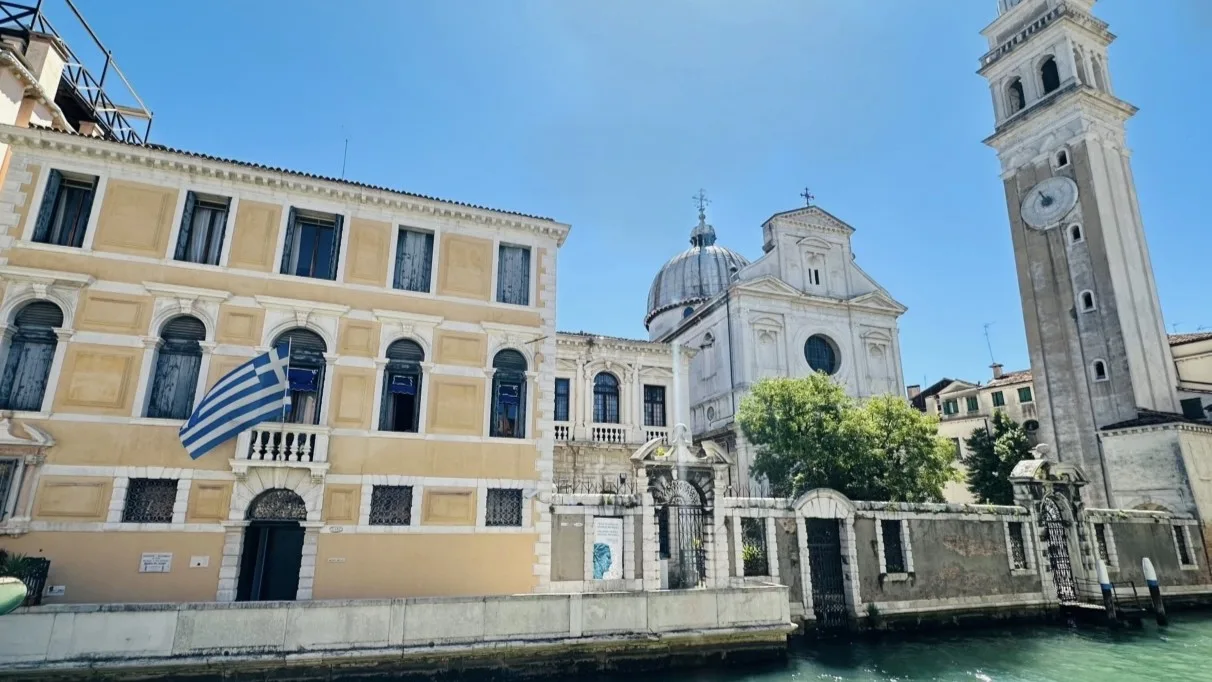By Dr. Themistocles Kritikakos (Historian)
The lagoon city of Venice in northern Italy once expanded into a powerful maritime empire, ruling territories across the Mediterranean, including parts of the Greek world. Yet the city itself became home to a vibrant and culturally significant Greek diaspora.
Hidden behind the grandeur of Saint Mark’s Basilica and the busy crowds of Saint Mark’s Square lies the Campo dei Greci (Greek Square), located in Venice’s Castello neighbourhood. This square, located beside the Rio dei Greci (Canal of the Greeks), formed the heart of the city’s Greek community. Today, the Greek flag proudly flies from the Hellenic Institute of Byzantine and Post-Byzantine Studies, housed in the former Flanginian School, which was once a beacon of Hellenic learning.
At the centre of this neighbourhood stands the Church of San Giorgio dei Greci (Saint George of the Greeks), with its distinctive leaning bell tower. During a two-week stay in the area a year ago, I came to appreciate more deeply the history of one of the earliest modern Greek diasporas, dating back to the 15th century. Here, language, culture, and faith have endured across centuries, telling a story of determination to preserve and advance Hellenism.
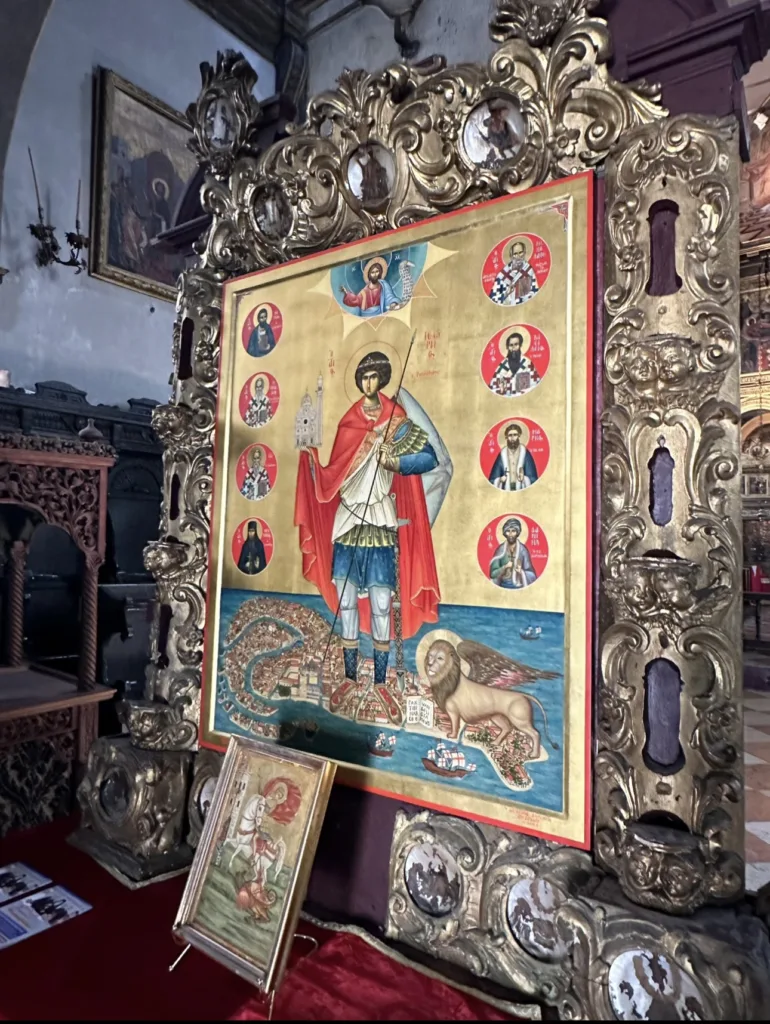

Greeks under Venetian Rule
Emerging as a maritime republic in the early Middle Ages, Venice grew into a major trading power linking East and West until its fall to Napoleon in 1797. It also played a significant role in shaping naval innovation, foreign relations, art, and culture throughout the Mediterranean and beyond. Following the Fourth Crusade and the sack of Constantinople in 1204, Venice’s involvement in the Greek world became prominent. From the early 13th century, it acquired Crete (1205), the Cyclades, Euboea, parts of the Peloponnese, and later the Ionian Islands. These dominions, which remained under Venetian control until the late seventeenth and eighteenth centuries, formed the core of the Stato da Mar and were instrumental in sustaining the Republic’s maritime empire and commercial prosperity. Cyprus also came under Venetian administration. These geopolitical shifts profoundly impacted not only territorial control but also the movement and self-expression of Greeks.
Crete, Venice’s most important overseas territory from 1205 to 1669, underwent administrative and religious reforms aimed at imposing Catholic structures and Venetian governance. Orthodox bishops were often replaced or overshadowed by Latin ones, and Orthodox clergy were marginalised. Venetian law took precedence over local customs, and church property was sometimes confiscated. These policies provoked uprisings, most notably the Revolt of Saint Titus in 1363. This rebellion, initially led by discontented Venetian nobles over tax impositions, was soon joined by members of the Greek population who attempted to establish an independent Cretan state.
Greek responses to Venetian rule varied widely. While some elites collaborated to retain privileges or relocated to Venice, others actively resisted foreign domination. Trade and development brought prosperity, cultural exchange, and infrastructural improvements. Though often motivated by strategic and commercial considerations, Venetian policies sometimes permitted coexistence and supported aspects of Greek cultural expression. Nevertheless, Venetian authorities maintained economic dominance, upheld legal hierarchies, and imposed religious control. They also periodically used force to assert their rule. These measures often led to tensions and episodes of resistance among local communities.
The struggle for St George of the Greeks
Amidst this complex political and religious setting, the Greek community in Venice sought to assert its spiritual identity, culminating in a long struggle for a church of their own. By the fifteenth and sixteenth centuries, Greek merchants, clergy, and intellectuals from both Venetian and Ottoman-controlled territories had formed a strong and influential community.
In 1498, the confraternity known as the Greek Brotherhood, or Scuola dei Greci (School of the Greeks), repeatedly appealed to the Venetian Senate for permission to build a dedicated Orthodox church. Despite demonstrating loyalty to the city and making substantial contributions, their appeals were consistently denied. This policy reflected Venice’s effort to maintain religious governance and uphold the primacy of the Catholic Church.
After decades of public petitions and diplomatic negotiations, permission was granted in 1539. The Church of San Giorgio dei Greci (St George of the Greeks) was completed in 1573, marking a significant moment of recognition. It became a lasting symbol not only of spiritual and cultural resilience but also of the careful compromises struck between Venetian political interests and Greek determination.
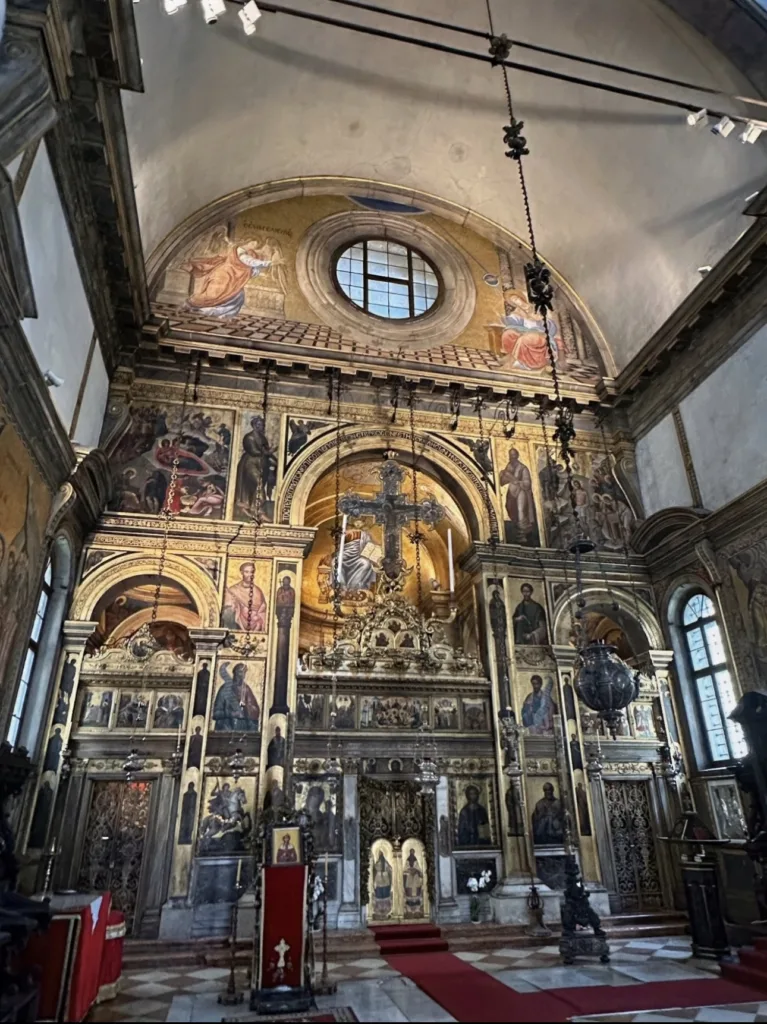
Upon entering the church, one encounters a large icon of Saint George standing on the island of Venice. The interior dome features a fresco of Christ and the Last Judgement, painted between 1589 and 1593 by the Cypriot artist Giovanni Kyprios, influenced by renowned Venetian Renaissance artist Tintoretto. These features embody a synthesis of Orthodox tradition and Venetian Renaissance aesthetics.
Cretan artists such as the post-Byzantine painter Michael Damaskinos, who contributed eighteen icons to the church’s gilded iconostasis, along with Renaissance-era priests and painters Emmanuel Tzanes and Philotheos Skoufos, enriched the interior with devotional works that preserved a deep spiritual heritage.
The flourishing of Greek art and thought
The renowned Cretan artist El Greco (Doménikos Theotokópoulos) was trained in the post-Byzantine iconographic tradition in Venetian-ruled Candia (modern-day Heraklion). In 1567, he migrated to Venice, where he absorbed the influence of Italian Renaissance masters such as Titian, Veronese, and Tintoretto, before later developing his mature style in Spain. His paintings reveal a noticeable integration of Orthodox iconography with Venetian artistic influences, reflecting the rich cultural exchanges within Venice’s Greek community.
The community upheld and nurtured its Hellenic identity through education and intellectual engagement. The School of the Greeks and the Flanginian School, a Greek educational institution supported by the merchant Thomas Flanginis of Corfu, operated from 1664 to 1905. These institutions became the cultural and educational heart of Venice’s Greek community. They cultivated a strong Hellenic identity through language, theology, philosophy, and classical studies, and contributed to the Diafotismos (Greek Enlightenment) of the eighteenth century. This intellectual and spiritual movement helped lay the groundwork for the Greek War of Independence in 1821. Venice also became a major centre of Greek-language printing. Liturgical, theological, and philosophical texts were produced in the city, helping preserve the Greek Orthodox faith and distribute Enlightenment ideas. The Greek diaspora in Venice helped shape the cultural and intellectual revival of Hellenism.
Greek mythology in the Venetian imagination
Venetian elites often viewed their republic as the heir of Rome and Byzantium, and they actively engaged with ancient Greek art and mythology. In the Palazzo Grimani, the Tribuna room features a sculpture of Zeus, depicted as an eagle, abducting the divine hero Ganymede. In the myth, Ganymede is taken by Zeus to serve as cupbearer to the gods, chosen for his exceptional qualities and elevated to divine status. Suspended mid-air and surrounded by replicas of over one hundred ancient Greek statues, the sculpture was installed in the mid-sixteenth century. It reflects the Renaissance revival of classical ideals, particularly the divine and the idealised human form.

During the neoclassical period, sculptor Antonio Canova reinterpreted Greek myths with deep emotional intensity. His statue of Orpheus and Eurydice at the Museo Correr (1775–76) portrays Orpheus’s doomed attempt to rescue his wife Eurydice from the underworld through the power of music, which moves the gods to grant her release on the condition that he does not look back until they reach the surface. Tragically, Orpheus’s premature glance leads to her permanent loss, and his intense expression of grief is powerfully conveyed in the sculpture. This myth reflects fundamental Hellenic themes such as love, loss, fate, destiny, and the human condition.
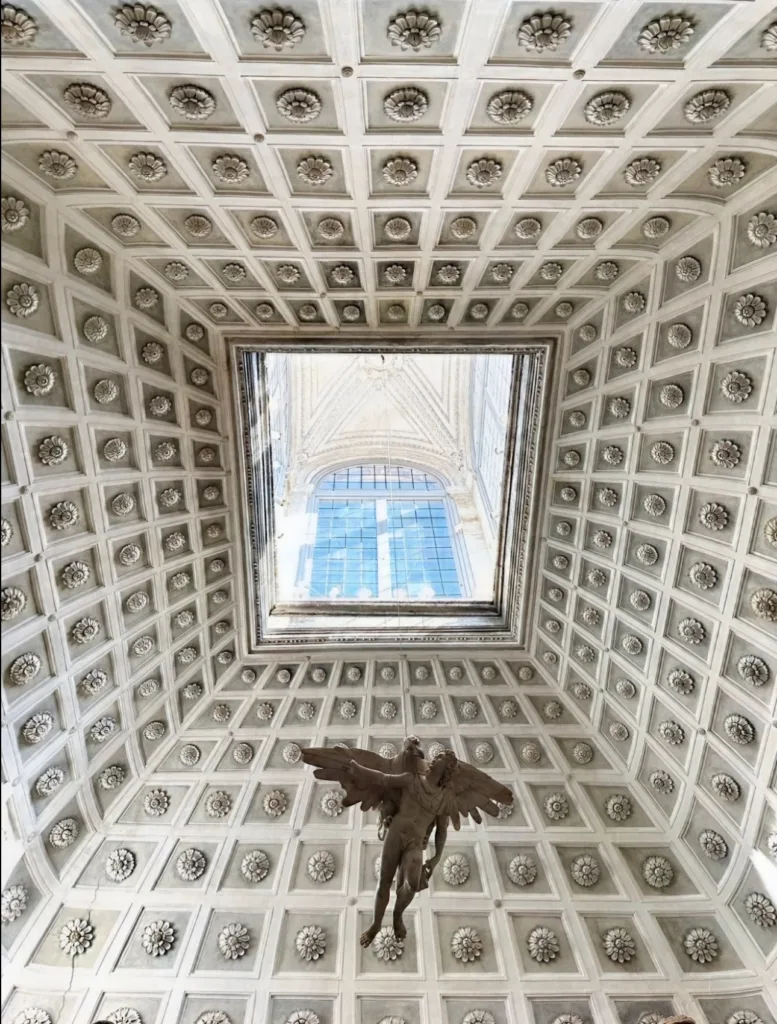
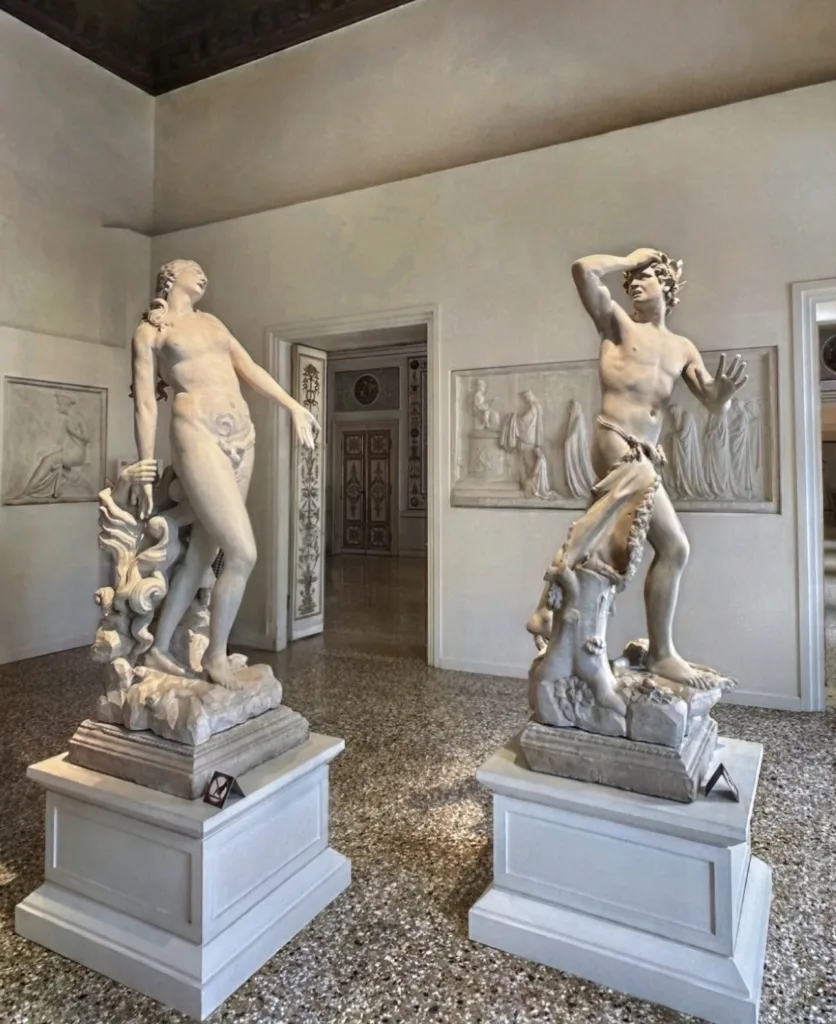
The Panagia Mesopantitissa: Icon of Survival
Venetian relations with the Ottoman Empire alternated between trade and military conflict. During the long siege of Candia (now Heraklion), from 1648 to 1669, Greek and Venetian forces resisted Ottoman attacks. When the city eventually fell, many Greek refugees fled to Venice. The Venetians brought the sacred icon of the Panagia Mesopantitissa (Virgin Mary, the Mediator) with them.
The icon was enshrined in the Basilica di Santa Maria della Salute (Basilica of Our Lady of Health), a church built by the people of Venice in fulfilment of a vow to the Virgin Mary during the plague of 1630–31. They had pledged to honour her with a church if she granted them protection. The icon came to symbolise not only divine protection but also a shared sense of devotion. It served as a spiritual link to Byzantium and invoked a sense of sacred continuity. For the Cretans, it represented survival, a sacred connection to their homeland, and an enduring symbol of faith in the diaspora.

Today, the Greek community in Venice is far smaller but still active. At its peak in the late fifteenth and sixteenth centuries, it consisted of approximately 5,000 people, making it the largest foreign population in the city. Even as the community diminished in numbers, its symbolic and spiritual legacy remained strong.
The Greeks of Venice demonstrate how diasporic communities embody resilience through adaptation and express devotion through cultural and artistic forms. In Venice, Hellenism evolved, leaving its mark on the city’s history, art, waterways, and spiritual life. It is a legacy that quietly endures.
Dr Themistocles Kritikakos is a Greek-Australian historian, philosopher and writer. He holds a PhD in History from the University of Melbourne. His forthcoming book explores intergenerational memories of violence in the late Ottoman Empire, identity, and communal efforts toward genocide recognition, focusing on the Armenian, Greek, and Assyrian communities in Australia.
All photos in this article are credited to the author.
Next week: Don’t miss the launch of the Magna Graecia (Great Greece) series, an exclusive new collection of articles by Dr Themistocles Kritikakos in The Greek Herald, exploring the legacy of Hellenism in Southern Italy.
